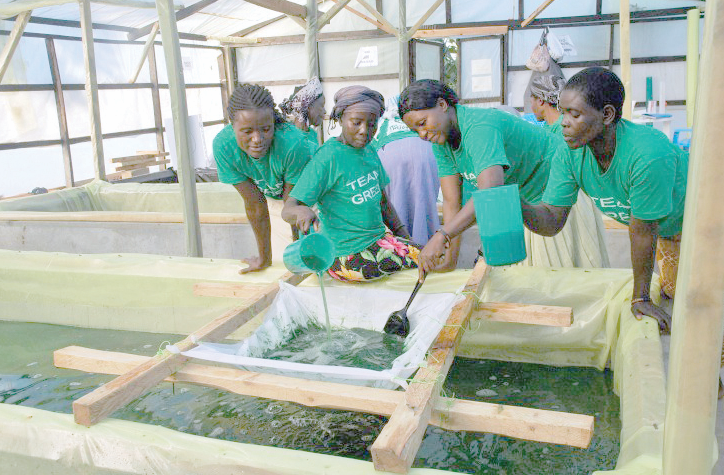Fighting malnutrition one capsule at a time

As you walk into Nasio Trust farm in Mumias, Kakamega County, you find women busy harvesting and processing spirulina.
Spirulina is an aquatic micro-organism often referred to as algae, though it more closely resembles bacteria. It is used as a food supplement to combat malnutrition.
“Our farm produces spirulina not for profit making, but to maintain the health of the children and communities we support in Western Kenya. We also sell the excess and the profits made from our spirulina sales are reinvested back into our community projects to advance the livelihoods of vulnerable people in Mumias West,” says Yohana Shieswe Chiema, Spirulina farm Manager.
Nasio Trust is a Kenyan Non-Governmental Organisation (NGO) that supports orphaned and vulnerable children, as well as the communities around them. They empower communities to break the cycle of poverty by adopting a holistic approach, which provides their beneficiaries with access to education, healthcare, food security, psychosocial support, and income-generating activities.
Supplement that can’t be ignored
Shieswe shares how this blue-green algae is incredibly nutrient-dense and is often used as a dietary supplement. It has extremely high protein levels and is packed full of beneficial vitamins such as iron, magnesium, and zinc. All of these factors make it perfect for treating malnutrition.
“Since we started producing spirulina, it is now an essential element of the meals at our early childhood development centres. Clinical officers at The Nasio Trust’s medical centre monitor patients presenting with malnutrition and provide them with spirulina supplements to improve their health status too,” he says.
He reveals that the organisation started the project of producing and processing this alga, which is exceptionally rich in protein (up to 70 per cent by weight) nearly three times as much as meat and fish in 2016 after being made aware of the health benefits of growing it, especially for people living with HIV and malnourished children. So far, the process has been refined and advanced culminating in a perfect product designed to maximise the health benefits of spirulina.
Shieswe notes how the first few months into this project was a learning curve. After the set-up period and the first harvest, they also experienced a major hurdle, which was selling the produce. Due to low awareness of spirulina, it was difficult to break into the local market.
However, they have since made inroads into the market, but are still trying to find ways to generate further income from their sales. They are hoping to soon have a license to stock the product in pharmacies and medical facilities across Kakamega County. They are also looking into the possibilities of online selling, to reach the whole country.
“Our organisation started by helping orphans and vulnerable children that had been afflicted by HIV. As many know, malnutrition is one of the challenges that this group faces. That is why, a product that is beneficial to malnourished children, as well as those that are HIV positive, was too exciting to ignore. It was our first venture into health supplements, but with external funding and the support of researchers, it has been a successful one,” Shieswe says.
Spirulina, he adds, possesses many health benefits such as lowering blood pressure, improving the immune system, and increasing appetite leading to weight gain, improved eyesight, and the prevention and treatment of arthritis. It is usually sold in either capsule or powder form. It can be consumed by swallowing the capsules or mixing the powder with food such as porridge or ugali.
The project also contributes to community development because the farm employs women, particularly those who are vulnerable due to widowhood, to give them a source of income. The women are trained in maintaining the spirulina cultures, drying them, and packaging them for final consumption.
Spirulina grows naturally in rivers. However, for the group, they grow it in a greenhouse as it also does well in a controlled environment. He reveals that when it comes to farming spirulina, there are a few things to keep in mind. It’s typically grown in large, shallow tanks where it can receive plenty of sunlight, and the water in the tanks need to be constantly stirred or aerated to prevent the spirulina from clumping together.
Expanding market
The temperature of the water also needs to be carefully regulated, as spirulina prefers warm water around 30°C. Additionally, it’s important to use high-quality water sources and to carefully monitor the nutrients in the water to ensure that the spirulina has all the nutrients it needs to thrive.
“We are currently undertaking research in partnership with Laikipia University and Wageningen University (in Netherlands) to establish whether spirulina farming can be scaled back to be more accessible to small-scale farmers. For example, we are exploring whether Spirulina can be grown outside of greenhouses and can be grown in buckets or small plastic basins,” Shieswe reveals.
Spirulina takes only five days to grow to maturity and be ready for harvest and that is why the organisation has managed to have enough for the children and patients and excess for sale even though they are doing it on a small scale. Since the market for this dietary supplement is there both locally and globally, they have also started training people about spirulina farming.
“None of the profits made is used for a private entity. Every shilling is reinvested into the community. We sell one capsule for Sh5 and a packet of 200 capsules goes for Sh1,000,” Shieswe says.
Spirulina is currently cultivated in many countries around the world, including the United States, Japan, India, China, Thailand, Chile, France, and many other countries. The largest producers of spirulina are currently China and India, but there are many smaller-scale spirulina farms in many other countries.
This farming is becoming more popular in Kenya. Spirulina cultivation has been growing in Kenya, especially in the regions around Lake Victoria. In recent years, there has been an interest in spirulina farming as a way to provide a sustainable source of nutrition and as a potential tool for poverty reduction.












